- Games, topic printables & more
- The 4 main speech types
- Example speeches
- Commemorative
- Declamation
- Demonstration
- Informative
- Introduction
- Student Council
- Speech topics
- Poems to read aloud
- How to write a speech
- Using props/visual aids
- Acute anxiety help
- Breathing exercises
- Letting go - free e-course
- Using self-hypnosis
- Delivery overview
- 4 modes of delivery
- How to make cue cards
- How to read a speech
- 9 vocal aspects
- Vocal variety
- Diction/articulation
- Pronunciation
- Speaking rate
- How to use pauses
- Eye contact
- Body language
- Voice image
- Voice health
- Public speaking activities and games
- Blogging Aloud
- About me/contact
- How to outline a speech

Sample speech outline template
Get a printable. Learn how to outline a speech effectively.
By: Susan Dugdale | Last modified: 02-20-2023
There's a printable sample speech outline template below for you to download and use.
Why? Because a well-completed outline becomes the backbone of your speech. You'll use it to guide you logically, and carefully, through ALL the aspects you need to consider before you actually write the speech itself.
It will help you clarify what material you want to cover to fit your audience, and speech purpose, as well as help to effectively organize it.
What you'll find on this page:
- t he reasons for using a speech outline
- how to outline a speech : the 4 essentials steps involved in writing an outline - detailed sequential help, with examples, covering: 1. choosing a topic, 2. audience analysis, 3. choosing the best organizational pattern to fit your speech purpose, 4. what to put in each part of your speech: introduction, body and conclusion
- a printable speech outline template to download
- links to 2 completed examples of speech outlines (a demonstration and a persuasive speech. Both with printable outlines to download.)
- a link to 7 completed examples of impromptu speech outlines , each with printable speech outline templates
- links to more resources for preparing an effective speech
Why bother writing a speech outline?
Because completing a speech outline is the first vital step toward preparing a successful speech.
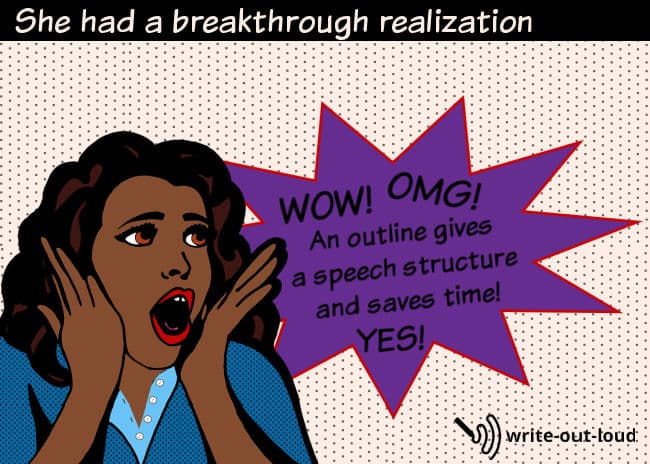
It is often overlooked in a misguided attempt to get on with what is considered the real work: writing the speech, or the words you're going to say.
Despite what many people think, time spent completing an outline is not wasted. Instead, it helps you save it. A nd sidestep any anxiety caused by inadequate preparation.
The process might appear daunting and horrifically time consuming but prepare a speech outline all the same.☺
What you'll learn about speech structure, matching content to your speech purpose and your audience's needs will pay you back over and over again. I promise you, having an outline will make giving a speech easier and less stressful.
How to best use this page
Read the page all the way through to familiarize yourself with the terms and the process. When you're done, click the link at the foot of the page to download and print the blank sample speech outline template for your own use.
How to outline a speech: 4 essential steps
The process of outlining a speech is broken down into 4 essential steps.
(Click a heading to find out more about each one)
- deciding on your topic
- considering the audience and refining your topic to suit them
- deciding on the purpose of the speech
- choosing an organizational method to support your speech purpose
- opening greeting and attention getter
- defining your thesis statement (a summary of what your speech is about)
- establishing your credibility
- an overview and the benefit to the audience
- transition or link between introduction and body
- main ideas with supporting ideas
- examples and details
- summary of main points
- closer or call to action
Remember this old saying?
First: tell them what you're going to tell them. Second: tell them. Third: tell them what you told them.
A simple, or basic, speech outline follows that advice.
- 'Tell them what you're going to tell them' becomes your introduction
- 'Tell them' forms the body
- 'Tell them what you told them' is your conclusion
Step 1 - Preparation for writing a speech outline
You need to complete this step before you do anything else. It is made up of five smaller steps, each of them an important part of the overall process. The decisions you make at this point will have a major impact on the final outcome of your speech.
By the time you are finished step 1 you will have:
- decided on your topic
- analyzed your audience
- refined your topic to meet the needs of your audience
- decided on the specific purpose of your speech
- chosen the best fitting of six organizational patterns to use - one matching your purpose and your material
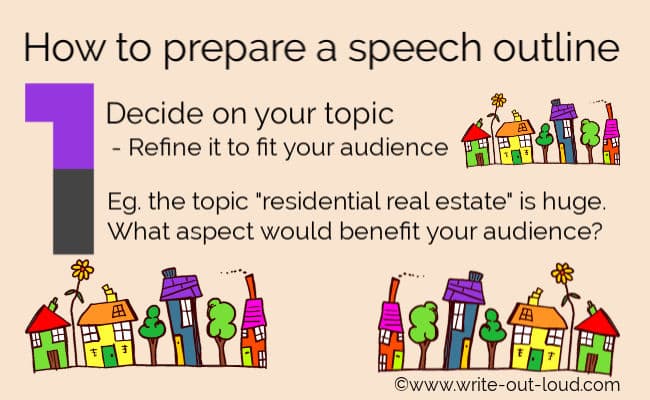
Start with choosing a topic
The place to begin is deciding what you are going to talk about.
For example, if you are a realtor (real estate agent) who has been asked to talk to a suburban community group residential real estate seems like a good logical topic to pick.
(If you don't have a topic in mind, go to speech topics . You'll find 100s of them ordered by speech type and theme.)
Put yourself to one side & focus on your audience
However, before you make a final decision considering more closely who will be listening to you makes better sense than assuming whatever you come up with will be right!
How do you really know what aspects of your topic are best suited to meet your audience's needs? Or what would be of real benefit for them to hear about?
The scope of the topic 'residential real estate' is huge.
Your speech could cover any number of sub-topics like: financial advice for first home buyers, how to thoroughly check a house before purchase, the rise of mortgagee default sales, the collapse of property development schemes, how to purchase properties for makeovers...
Analyze your audience
So before you settle on the exact topic of your speech analyze your audience .
Without analysis you are 'guessing' what would be interesting and relevant for them to hear.
Refine your topic
Using what you found out about your audience, decide on an aspect of your topic that will be of benefit to them and the angle you will take on it. Take care with this. One size does not fit all!
For example a speech on housing affordability which includes a step by step plan toward buying a first home will likely interest an audience of youngish, (late 20s- early 40s), people with steady professional incomes.
But for another audience, (e.g. one that is older, less financially secure, or younger and not ready to consider settling yet...), it could be completely inappropriate.
Minimize the risk of getting it wrong by finding out as much as you can about your audience.
Deciding on the purpose of your speech
What is the purpose of this speech? Why are you giving it?
Is it to persuade or inform? Is it to demonstrate, entertain, or welcome? Or is it a combination of these?
What do you want your speech to achieve? Is there a particular action you want people to take as a result of listening to you?
Your answers to all of these questions will dictate what organizational pattern you'll use for your speech, its content and tone.
Return to Top
Choosing an organizational pattern or method

There are 6 basic organizational patterns or methods of arranging the body (main points) of your material. Choose the one most appropriate for your need.
1. Cause - Effect
Because event 'A' happened, event 'B' occurred.
- Because the driver was speeding, they crashed the car.
- Because of the earthquake, the city was destroyed.
- Because the minimum wage is low, families can not afford good health care.
2. Problem - Solution
The problem is 'X'. The answer is 'Y'.
- The problem is unaffordable housing. The solution is community funded housing complexes.
- The problem is unemployment. The solution is meaningful, sustainable education and employment programs.
- The problem is poor food choices. The solution is practical community outreach programs to teach people about nutrition, food buying, storage and preparation, along side living wages, educational and employment programs.
This pattern suits a broad topic which can be broken down into naturally occurring sub-topics.
- The broad topic is 'Vocal Variety'. Its sub-topics include rate of speech, use of pausing, voice tone, volume, articulation...
- The broad topic is 'Organizational speech patterns'. Sub-topics could be problem-solution, cause- effect, logical...
- The broad topic is 'Residential real estate'. Its sub-topics could include houses for first-home buyers, how to apply for a mortgage, how to select the right neighborhood to buy in, the impact of high-density housing...
4. Spatial or geographic
Use this pattern for topics dealing with physical spaces.
- The 10 most popular tourist attractions in New Zealand.
- The European migration patterns of the 19th century.
- The population shift from country to town in USA.
5. Time or chronological/sequential
These are either historical topics or demonstration speeches. The foundation of both is an ordered sequence of events.
For example:
- The history of women's suffrage in USA, the abolition of slavery
- How to bake a cake, how to mend a puncture in a bicycle tire, or how to knot a tie
6. Advantage - disadvantage
Use this pattern to examine the range of positive and negative aspects of an idea or event.
- What are the advantages and disadvantages of private schooling?
- What are the advantages and disadvantages of lowering the voting age?
- What is good about supporting local industry? What is negative about supporting local industry?
Step Two - Outlining the introduction
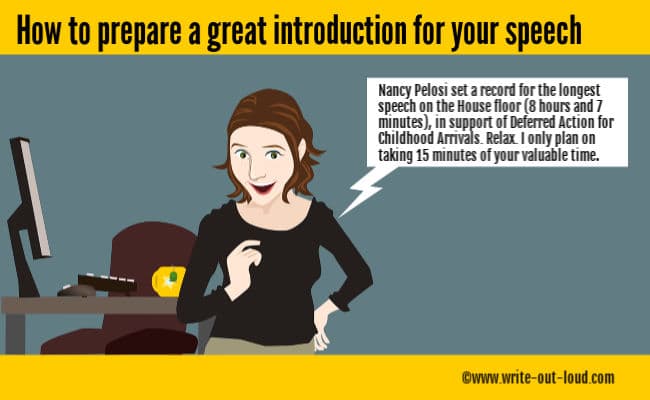
The 5 parts of preparing an introduction
1. greeting & attention getter.
How are you going to greet your audience, grab their attention and compel them to listen?
You could use a rhetorical question, a startling statistic, a quotation or a humorous one-liner. To be effective it must be related to your topic and apt for your audience.
- Rhetorical question How many of you really are more afraid of public speaking than death?
- A startling statistic Apparently in USA 75% of the population experiences public speaking anxiety. Some just a little. And some a lot.
- A quotation Mark Twain famously said, there are only two types of speakers in the world: the nervous and the liars.
- Humorous Speaker of United States House of Representatives, Nancy Pelosi set a record for the longest speech on the House floor: 8 hours and 7 minutes. Relax. I only plan on taking 15 minutes of your valuable time. * * Be careful with humor. It will only work if it's appropriate; that is fitting for the occasion, and understood by the majority of your audience. For more about Nancy's record: Nancy Pelosi's all-day marathon speech sets record as longest continuous speech since at least 1909.
For more on effective speech openings see: How to write a speech introduction - 12 of the best ways to start a speech
2. Thesis statement
This is a short summary of your speech topic and your point of view or angle.
Example:
Green politics is no longer a fanciful fringe fad. It is a necessity.
3. Credibility
This segment establishes your right to speak on the topic. It cites your qualification or expertise.
Using myself as an example, I can speak about preparing speeches because I've written many over the past twenty or so years. Prior to becoming a professional speech writer , I taught high school level English and drama and I also belonged to the global public speaking club Toastmasters for a long time.
4. Summative overview
This is a brief outline of the main points you are going to cover.
Today I am going to share with you three effective ways to lessen public speaking fear.
The first and second cover aspects of preparation: writing and rehearsal or practice: actually doing the work, rather than being frightened of it. ☺ The third is about the benefits of public speaking.
5. Benefit(s)
What's in your speech for your audience? Why will they want to hear what you've got to tell them? Be specific. Tell them.
When you make a decision to speak up in public you also gain: confidence, the ability to take on leadership roles, a growing collection of presentation skills like story telling, how to use your voice, the ability to use props well, how to listen, how to craft a speech to meet the needs of specific audiences... In short, you release the potential to become a bigger and better you * .
( * For more see 14 benefits of public speaking .)
Step Three - Outlining the body of your speech
This is the heart of your speech, the place where you lay out what you want to share with your audience.
Generally three main ideas, along with supporting examples, work more effectively than four or five or more. If you have a number of them to choose from, go with your three strongest points. And if one of your final three is noticeably weaker sandwich it between the other two.
If you intend to use visual aids (slides showing graphs, tables or images), or actual props, mark them in too.
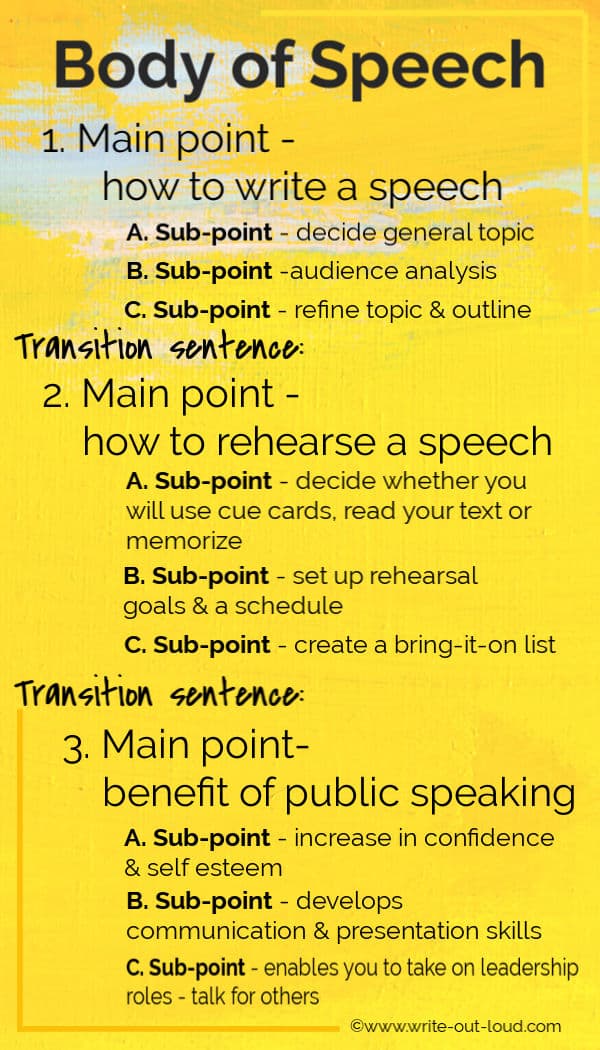
Note: If you're unsure about the exact nature of links or transitions and how they work or what they are, you'll find more about them, with examples, on my page how to write a speech
- Main Idea 3 - Supporting ideas - Details and examples - Visuals or props - Transition to...
Step Four - Outlining the conclusion of your speech
There are four parts to preparing an effective conclusion to your speech. Use them to draw together and summarize all the material from your introduction and the body of your speech, and end with a clincher!
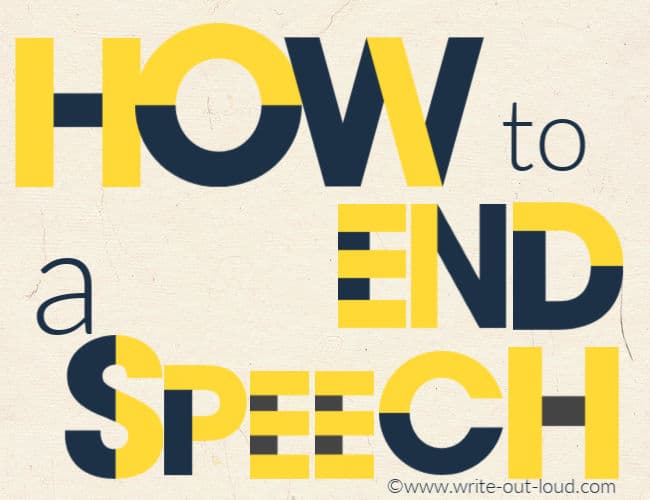
- Summary of main ideas These are the main points you covered in the body of your speech.
- Re-statement of thesis statement Use the statement from your introduction to reinforce your message.
- Re-statement of benefit to audience Remind the audience of the benefits they'll receive through carrying out whatever your propose. Again this comes from your introduction.
- Closer, Clincher or Call to Action This is your final sentence. To ensure your speech ends with a bang rather than a whimper check out this page on how to end a speech memorably. You'll find options and examples.
Get your printable sample speech outline template
This is a simple four page PDF of all four steps and their sub- headings with spaces for you to write your notes. Click to download and print your sample speech outline now.
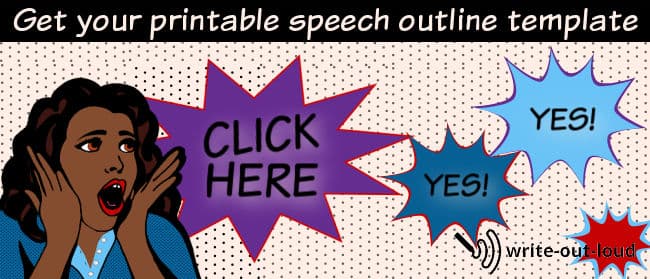
2 completed examples of speech outlines
Use these links to go to a fully completed:
- demonstration speech outline example on how to leave an effective voice mail message (with a free printable sequential demonstration speech outline template)
- persuasive speech topic outline example on overcoming public speaking fear using Monroe's Motivated Sequence (with a free printable MMS persuasive speech outline template)
Example impromptu speech outline patterns
Impromptu speech outline patterns - seven different structural formats, each with completed examples and a free blank printable outline for you to download and use.

Other resources for preparing successful speeches
Planning and writing, rehearsing a speech.
Once you're done with planning, completing your sample speech outline and writing find out how to rehearse. A speech is a live performance. Rehearsal helps you expose and iron out glitches before you find them out the hard way - in front of your audience.
Speech evaluation
And if your speech is being assessed check out this standard speech evaluation form to see what aspects are likely to be judged and how a rating scale works.
- Return to the top
speaking out loud
Subscribe for FREE weekly alerts about what's new For more see speaking out loud

Top 10 popular pages
- Welcome speech
- Demonstration speech topics
- Impromptu speech topic cards
- Thank you quotes
- Impromptu public speaking topics
- Farewell speeches
- Phrases for welcome speeches
- Student council speeches
- Free sample eulogies
From fear to fun in 28 ways
A complete one stop resource to scuttle fear in the best of all possible ways - with laughter.

Useful pages
- Search this site
- About me & Contact
- Free e-course
- Privacy policy
©Copyright 2006-24 www.write-out-loud.com
Designed and built by Clickstream Designs
- TemplateLab
- Informative Speech Outline
43 Informative Speech Outline Templates & Examples
Are you looking for ways to make your informative speech interesting? There are multiple ways through which you can make it sound interesting to your audience. If you are a student, you may have to write such kind of speeches every now and then. Besides students, business owners also have to come up with such kind of speeches for their audience.
Table of Contents
- 1 Informative Speech Outline Examples
- 2 What is an Informative Speech?
- 3.1 Definitional Speech
- 3.2 Descriptive Speech
- 3.3 Explanatory Speech
- 3.4 Demonstration Speech
- 4 Informative Speech Outline Templates
- 5.1 Eye Contact
- 5.2 Tone of Your Voice
- 5.3 Expressive Hand and Body Gestures
- 6 Informative Speech Samples
- 7 Tips for Your Informative Speech from a Professional
You can use multiple ways to enhance your informative speeches. In order to know more about informative speeches, its types, and how you can make it sound interesting, read through this article
Informative Speech Outline Examples
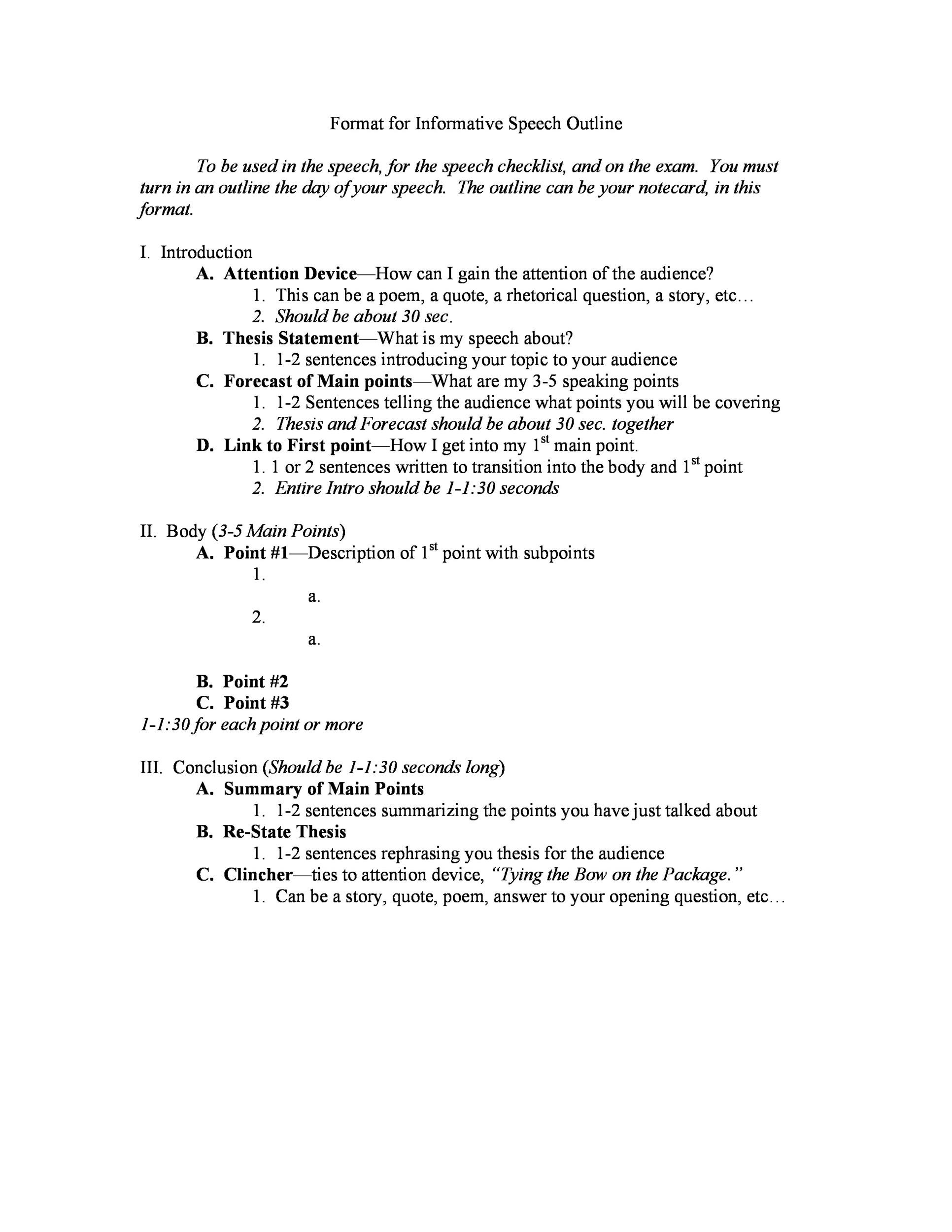
What is an Informative Speech?
An informative speech is a type of speech mostly based on facts and figure. The facts are presented in front of the audience to teach them about a specific topic. It is necessary for an informative speech to have reliable sources to support claims. At times, presenters think to add some life to their speeches by putting in visual aids, images or appealing photographs. This is done to ensure that the audience remains engaged and not get overwhelmed with just facts and figures. As the name implies, an informative speech likely focuses on the general information covering history, evolution and other necessary information in order to teach the audience about a specific topic. For instance, if you are giving an informative speech about baking bread, you can explain the history of bread, its evolution and how to bake it efficiently. Sometimes, people often think that informative essays and informative speeches are one as the same thing, but it is not so. Unlike informative essays , the presentation is the key element for informative speeches.
Furthermore, while giving an informative speech, your tone can vary. You can fluctuate your tone, raising your voice or talking normally. But most importantly, you should include credible sources to support your ideas and claims. The audience can become more knowledgeable on the subject. The speaker of the informative speech should be well-versed about the entire subject and able to answer the detailed questions that are asked. The speaker should do thorough research on the topic and should be able to defend their side.
Normally, there are four types of topics for informative speeches: concepts, objects, events, and processes. Like other types of speeches, an informative speech also has an introduction, body, and conclusion. So, make sure you do include all the parts in order to make the right kind of informative speech outline. If you are not sure about the informative speech outline, you can download the informative speech outline template. We have several different kinds of informative speech outline examples for you. Simply download any of them and edit it with your speech.
Additionally, informative speech is unlike the persuasive speech as it just highlights the facts and figures in order to draw upon conclusions. On the contrary, persuasive speech has certain opinions and conclusions in the speech besides the sourceable facts. An informative speech has limitless options. From fictitious to non-fictitious topics, informative speeches can be given on any kind of topic. But just make sure that you have enough knowledge about it. All in all, the main goal of the informative speech is to provide enlightenment about the specific topic the audience does not know about.
Types of Informative Speeches
Now that you have understood what actually informative speech is, you should also understand that there are different types of speeches. Check out the four types below.
Definitional Speech
In the definitional speeches, the speaker explains the meaning of theories, concepts, issues and philosophies that the audience may not know about. In such types of speeches, the speakers may begin by providing a history of the topic and background to the subject. Let’s continue the similar example which we mentioned above of baking bread.
Considering this example under this form of speech, the speaker would elucidate about what a bread actually is, the history of the bread, how it changed from time and what are the parts of a bread called. The speaker will give shape to such kinds of things throughout the speech.
Descriptive Speech
The purpose of a descriptive speech is to provide vivid and detailed information of a person, place, animal, or thing. Also, it is supported by a word picture. This kind of informative speech is different from the definitional speeches because it helps in determining the characteristics, functions, features and the key points of the topic.
For instance, if you are providing a speech on the famous Statue of Liberty in the United States, you should let the audience know all about its nuts and bolts. You should know what kind of material is used in order to make it, how it was made, what is its historical significance, why is it located on that spot etc. There are many things that you need to answer in these kinds of descriptive speeches.
Explanatory Speech
An explanatory speech is also known as a briefing. Explanatory speech is somehow like descriptive speech as both of them share the function of clarifying the topic. But these kinds of speeches mostly focus on reports of historical and current events, transformations, customs, inventions, outcomes, policies, and options.
Additionally, these speeches focus on the explanations more, considering how and why aspect most importantly. On the contrary, descriptive speeches do not go in too many details while the explanatory speeches go into depth.
Demonstration Speech
Demonstration speech type is also one of the informative speech types that help listeners determine how to accomplish or perform things on their own. This type of speech is based on demonstration. When speakers have to give this type of speech, they focus on the processes having a series of steps which has specific beginning and ending. These types of speeches are normally given to the audience who do not have any know-how about the product. For instance, if a representative is giving speech to the audience in public about a product, they would use demonstration speech approach.
Also, there are certain products that include set of tools and associated features. It can be quite challenging to write the demonstration speeches as they may include several objects, steps, features, related events or relationships. If you want to prepare this speech, you should first remember to keep safety of the audience in your mind. You should make sure that the tools or elements you are using do not hurt the audience.
For instance, if you want to give a demonstration speech using fire, make sure that you do it carefully. There have been many cases in history when demonstration speeches have gone wrong. So, you must ensure to keep the safety of the audience in your mind. Besides, if you want to write a demonstration speech, we have a template available for that too. Simply download it and edit the outline with respect to your needs.
Informative Speech Outline Templates
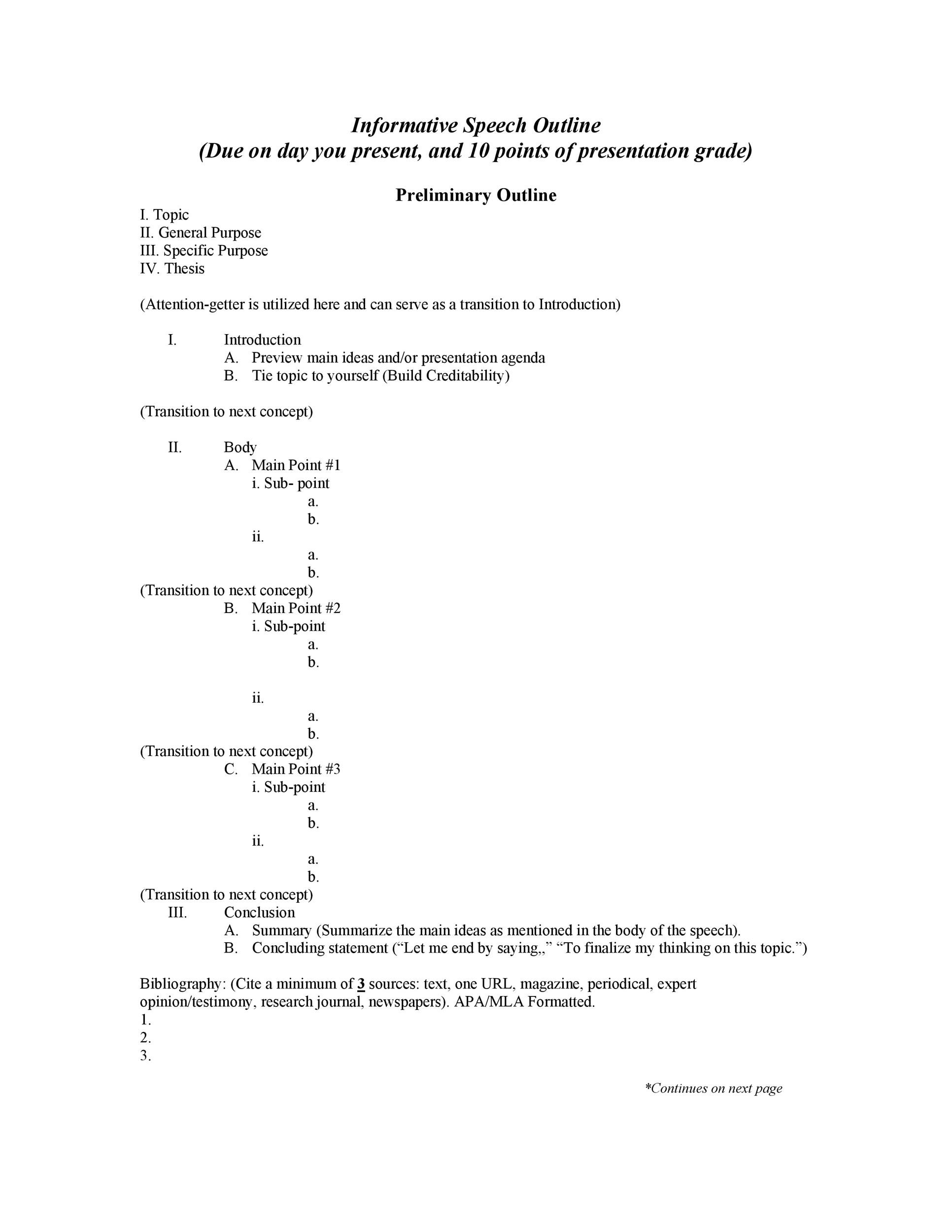
Checklist for Your Informative Speech
According to a research, when you give speech to the audience, words are the least important part while communicating. As per the study, when you do face-to-face conversation with others, you need to focus on your actions. Here are some elements that you need to take care of. Find the checklist for your informative speech below.
Eye Contact
Your audience will get bored if you just read through the text on the presentation. This would not help the audience in understanding the speech you are giving to them. A good speech is the one which is supported by proper eye contact and is accompanied with good presentation skills. Also, according to a study, effective communication is based on trust.
Your audience will trust you if you make an eye contact with them. You should see into the eyes of the audience in order to evaluate if they are interested and grasping the idea or not. The cooperation increases when we watch the audience. When you would make an eye contact, it would increase trustworthiness and also encourage future cooperation.
Tone of Your Voice
In addition to making an eye contact, the tone of your voice is equally important when it comes to giving a speech. Your audience will not be interested if you give the speech in a monotonous tone. Also, informative speeches may also get dull due to the facts and figures in it. Along with the tone of your voice, the facial expressions also matter.
According to experts, if the tome remains the same, neural dissonance takes place inside the brain causing confusion in the person. In order to express joy, your voice should become increasingly melodic and when you want to portray sadness, you can shift your tone to monotonic. There is a lot of variability in both, the speed and tone.
Expressive Hand and Body Gestures
Hand and body gestures also play a very important role. Your audience would get really very bored if you stand straight in one position and do not use your hand and body gestures. The gestures are really very important as they help in the comprehending the language. Audience’s brain would want both, your sound as well as your body movements in order to accurately perceive what is meant.
According to a research, if our gestures and words are dissimilar, it will likely create a confusing state for the listener’s brain. So, you need to ensure that you use your hand and body gestures during your speech but make sure that you do it at the right time. We would suggest you to practice speaking in front of the mirror and use your hands in order to describe the words that you are going to speak in front of the audience.
Informative Speech Samples
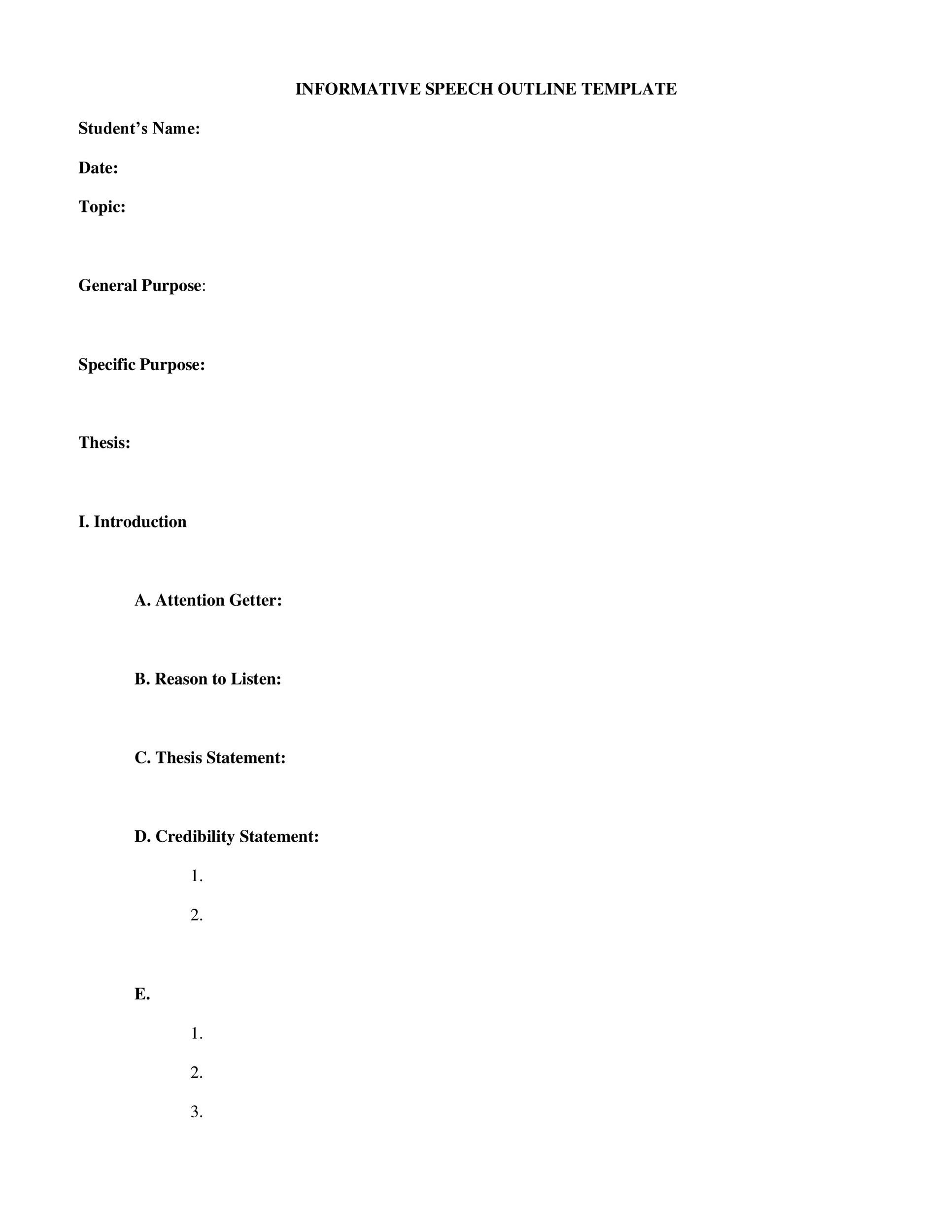
Tips for Your Informative Speech from a Professional
If you want to write an effective informative speech, then you should be following the tips below by the professional.
- You should be providing information in every minute of your speech. There should not be any filler texts or information. An informative speech is made for the core reason to make every minute worth for the audience. Keep in mind that you are not trying to impress them; you are just trying to provide them information during your speech.
- In addition to providing information to the audience, you should also give examples of real world situations so that your audience can relate to the information on practical basis. You are just there to help your audience learn information.
- Make sure that you make an eye contact with your audience in order to help them trust you. Remember that your goal is to educate the audience and make them believe in what you say.
- You should be quite sincere and credible about the speech you are giving to your audience. You should not put the information that you think is not reliable.
- At the end of the information speech, you should be ready to ask questions. Or let your audience know that you would ask them in the end so that they stay prepared by the end of the session.
Informative speech outline is readily available on our main website. If you are looking for informative speech outline template of any type, you can download it from our main website and use for your effective informative speech. We hope our templates help you in giving the best speech.
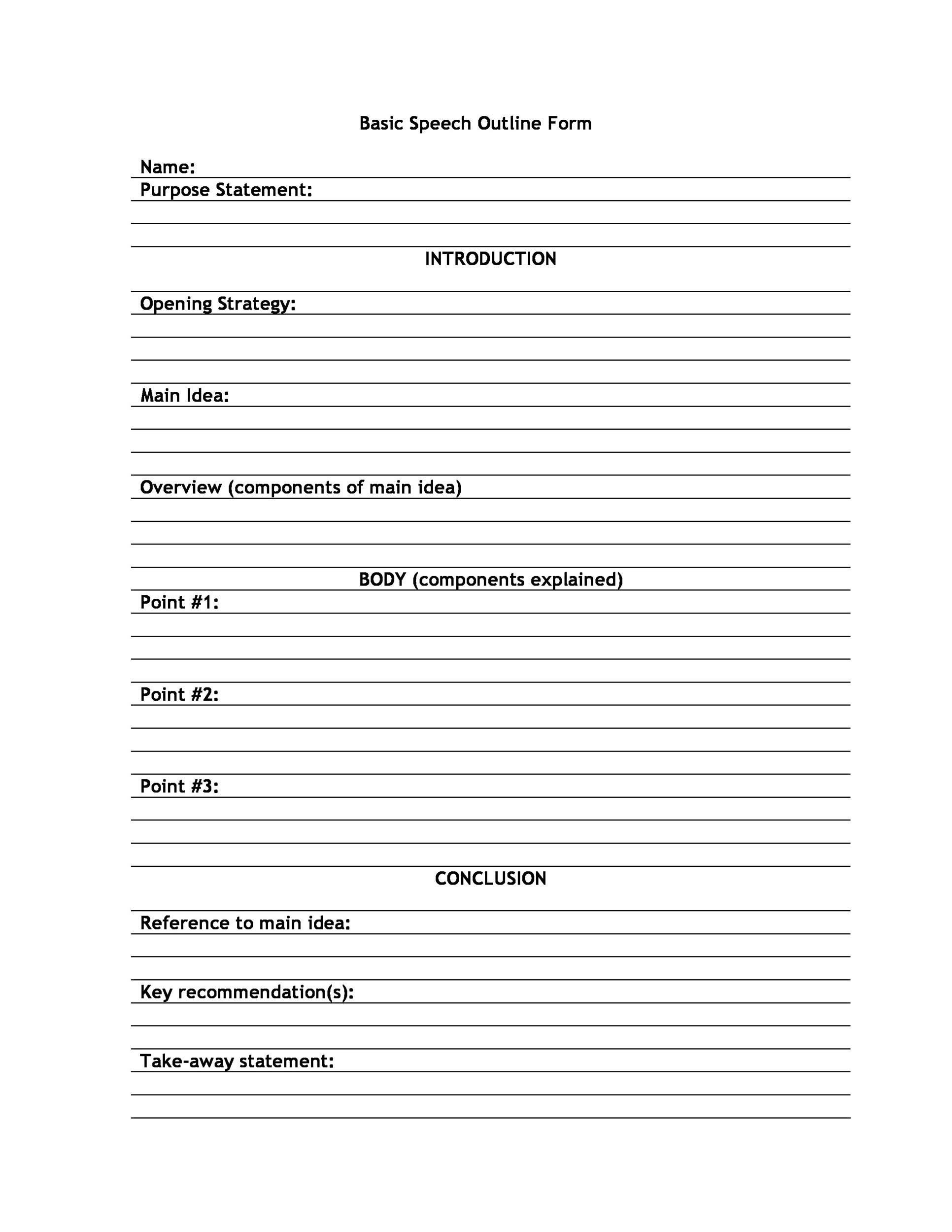
More Templates
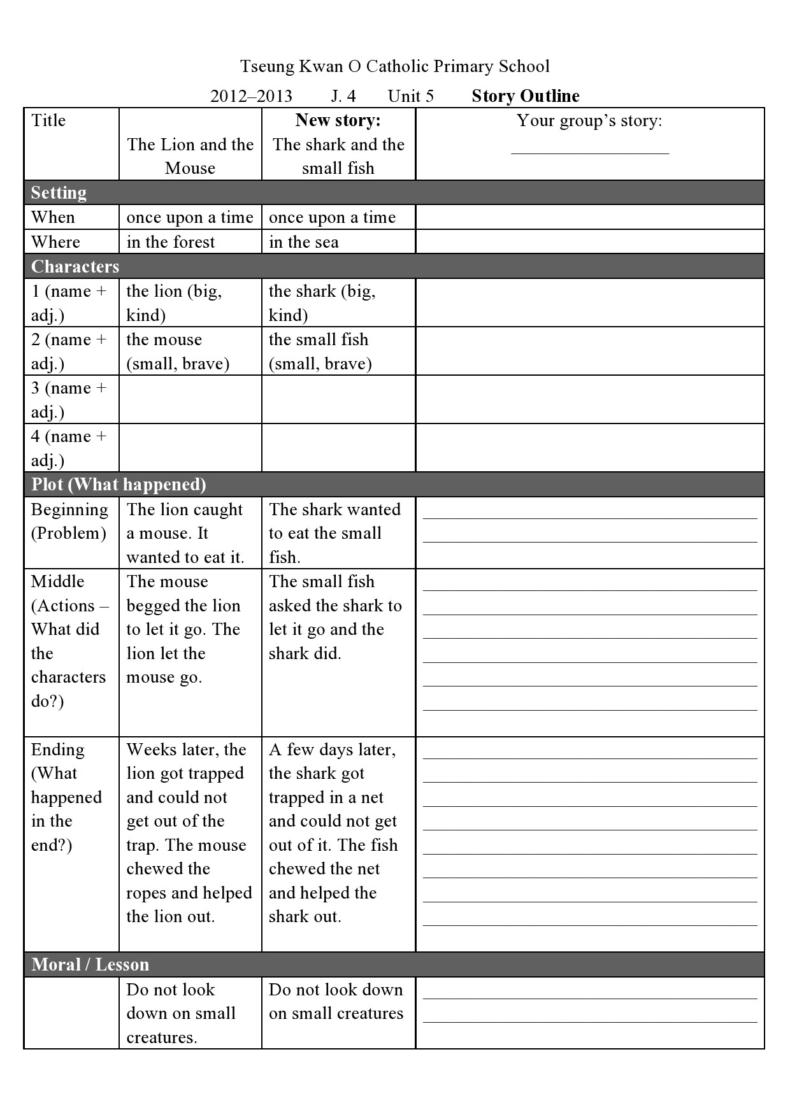
Story Outline Templates
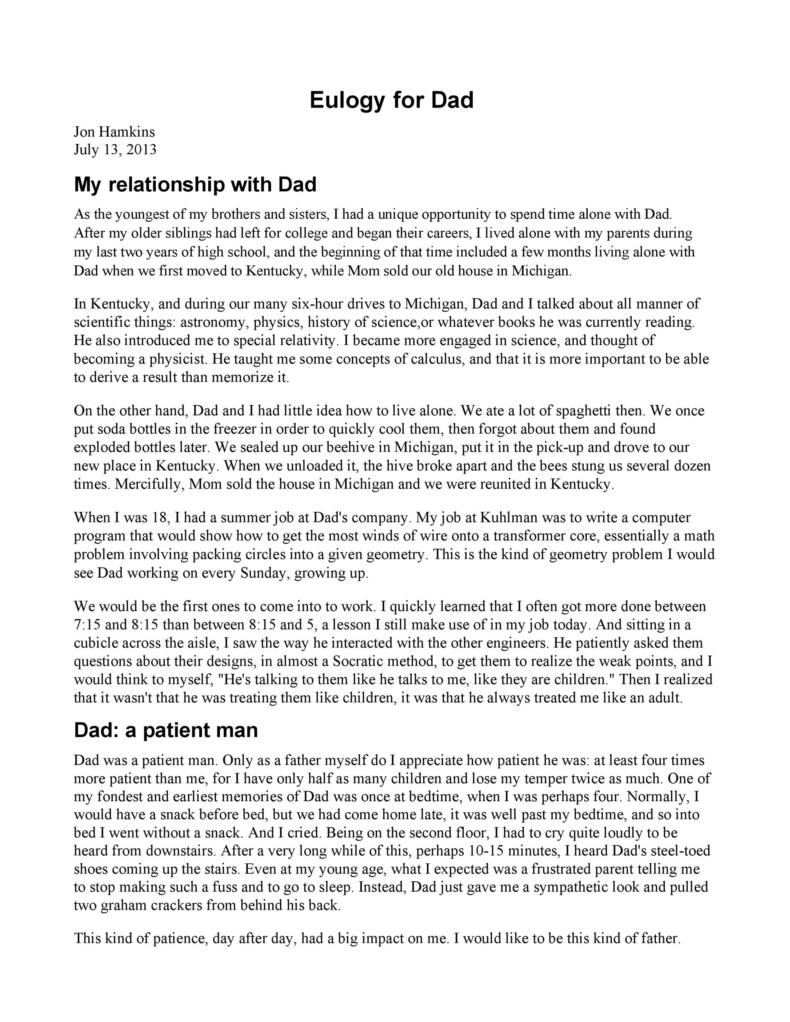
Eulogy Templates
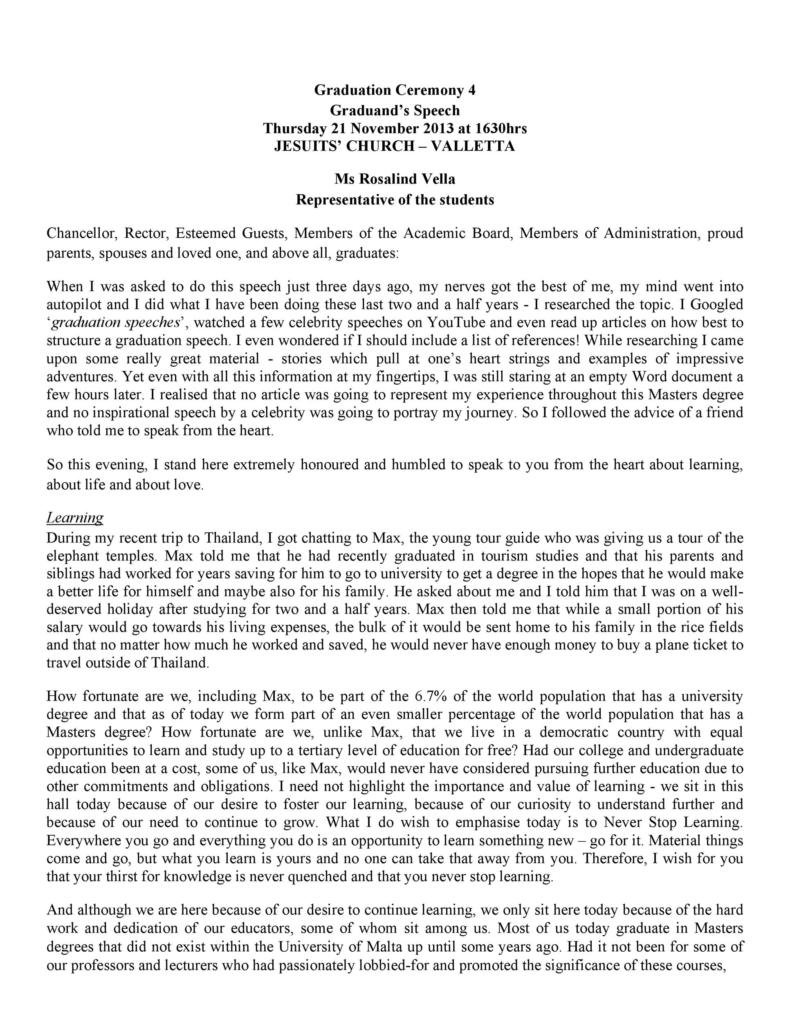
Graduation Speech Examples

How to Write an Effective Speech Outline: A Step-by-Step Guide
- The Speaker Lab
- March 8, 2024
Table of Contents
Mastering the art of speaking starts with crafting a stellar speech outline. A well-structured outline not only clarifies your message but also keeps your audience locked in.
In this article, you’ll learn how to mold outlines for various speech types, weaving in research that resonates and transitions that keep listeners on track. We’ll also show you ways to spotlight crucial points and manage the clock so every second counts. When it’s time for final prep, we’ve got smart tips for fine-tuning your work before stepping into the spotlight.
Understanding the Structure of a Speech Outline
An effective speech outline is like a map for your journey as a speaker, guiding you from start to finish. Think of it as the blueprint that gives shape to your message and ensures you hit all the right notes along the way.
Tailoring Your Outline for Different Speech Types
Different speeches have different goals: some aim to persuade, others inform or celebrate. Each type demands its own structure in an outline. For instance, a persuasive speech might highlight compelling evidence while an informative one focuses on clear explanations. Crafting your outline with precision means adapting it to fit these distinct objectives.
Incorporating Research and Supporting Data
Your credibility hinges on solid research and data that back up your claims. When writing your outline, mark the places where you’ll incorporate certain pieces of research or data. Every stat you choose should serve a purpose in supporting your narrative arc. And remember to balance others’ research with your own unique insights. After all, you want your work to stand out, not sound like someone else’s.
The Role of Transitions in Speech Flow
Slick transitions are what turn choppy ideas into smooth storytelling—think about how bridges connect disparate land masses seamlessly. They’re not just filler; they carry listeners from one thought to another while maintaining momentum.
Incorporate transitions that feel natural yet keep people hooked. To keep things smooth, outline these transitions ahead of time so nothing feels left up to chance during delivery.
Techniques for Emphasizing Key Points in Your Outline
To make certain points pop off the page—and stage—you’ll need strategies beyond bolding text or speaking louder. Use repetition wisely or pause strategically after delivering something significant. Rather than go impromptu, plan out what points you want to emphasize before you hit the stage.
Timing Your Speech Through Your Outline
A watchful eye on timing ensures you don’t overstay—or undercut—your moment under the spotlight. The rhythm set by pacing can be pre-determined through practice runs timed against sections marked clearly in outlines. Practice will help ensure that your grand finale isn’t cut short by surprise.
Ready to Get Your First (Or Next) Paid Speaking Gig?
Download our free 26-page guide and get the 14 exact steps you can follow to book a paid speaking gig right now!
Depending on the type of speech you’re giving, your speech outline will vary. The key ingredients—introduction, body, and conclusion—are always there, but nuances like tone or message will change with each speaking occasion.
Persuasive Speeches: Convincing With Clarity
When outlining a persuasive speech, arrange your arguments from strong to strongest. The primacy effect works wonders here, so make sure to start off with a strong point. And just when they think they’ve heard it all, hit them with an emotional story that clinches the deal.
You might start by sharing startling statistics about plastic pollution before pivoting to how individuals can make a difference. Back this up with data on successful recycling programs which demonstrate tangible impact, a technique that turns facts into fuel for action.
Informative Speeches: Educating Without Overwhelming
An informative speech shouldn’t feel like drinking from a fire hose of facts and figures. Instead, lay out clear subtopics in your outline and tie them together with succinct explanations—not unlike stepping stones across a stream of knowledge.
If you’re talking about breakthroughs in renewable energy technology, use bullet points to highlight different innovations then expand upon their potential implications one at a time so the audience can follow along without getting lost in technical jargon or complexity.
Ceremonial Speeches: Creating Moments That Matter
In a ceremonial speech you want to capture emotion. Accordingly, your outline should feature personal anecdotes and quotes that resonate on an emotional level. However, make sure to maintain brevity because sometimes less really is more when celebrating milestones or honoring achievements.
Instead of just going through a hero’s whole life story, share the powerful tales of how they stepped up in tough times. This approach hits home for listeners, letting them feel the impact these heroes have had on their communities and sparking an emotional bond.
Incorporating Research in Your Speech Outline
When you’re crafting a speech, the backbone of your credibility lies in solid research and data. But remember, it’s not just about piling on the facts. It’s how you weave them into your narrative that makes listeners sit up and take notice.
Selecting Credible Sources
Finding trustworthy sources is like going on a treasure hunt where not all that glitters is gold. To strike real gold, aim for academic journals or publications known for their rigorous standards. Google Scholar or industry-specific databases are great places to start your search. Be picky. Your audience can tell when you’ve done your homework versus when you’ve settled for less-than-stellar intel.
You want to arm yourself with evidence so compelling that even skeptics start nodding along. A well-chosen statistic from a reputable study does more than decorate your point—it gives it an ironclad suit of armor.
Organizing Information Effectively
Your outline isn’t just a roadmap; think of it as scaffolding that holds up your argument piece by piece. Start strong with an eye-opening factoid to hook your audience right off the bat because first impressions matter—even in speeches.
To keep things digestible, group related ideas together under clear subheadings within your outline. Stick to presenting data that backs up each key idea without wandering down tangential paths. That way, everyone stays on track.
Making Data Relatable
Sure, numbers don’t lie but they can be hard to connect to. If you plan on using stats in your speech, make them meaningful by connecting them to relatable scenarios or outcomes people care about deeply. For instance, if you’re talking health statistics, relate them back to someone’s loved ones or local hospitals. By making the personal connection for your audience, you’ll get their attention.
The trick is using these nuggets strategically throughout your talk, not dumping them all at once but rather placing each one carefully where its impact will be greatest.
Imagine your speech as a road trip. Without smooth roads and clear signs, the journey gets bumpy, and passengers might miss the scenery along the way. That’s where transitions come in. They’re like your speech’s traffic signals guiding listeners from one point to another.
Crafting Seamless Bridges Between Ideas
Transitions are more than just linguistic filler. They’re strategic connectors that carry an audience smoothly through your narrative. Start by using phrases like “on top of this” or “let’s consider,” which help you pivot naturally between points without losing momentum.
To weave these seamlessly into your outline, map out each major turn beforehand to ensure no idea is left stranded on a tangent.
Making Use of Transitional Phrases Wisely
Be cautious: overusing transitional phrases can clutter up your speech faster than rush hour traffic. Striking a balance is key—think about how often you’d want to see signposts on a highway. Enough to keep you confident but not so many that it feels overwhelming.
Pick pivotal moments for transitions when shifting gears from one major topic to another or introducing contrasting information. A little direction at critical junctures keeps everyone onboard and attentive.
Leveraging Pauses as Transition Tools
Sometimes silence speaks louder than words, and pauses are powerful tools for transitioning thoughts. A well-timed pause lets ideas resonate and gives audiences time to digest complex information before moving forward again.
This approach also allows speakers some breathing room themselves—the chance to regroup mentally before diving into their next point with renewed vigor.
Connecting Emotional Threads Throughout Your Speech
Last but not least, don’t forget emotional continuity, that intangible thread pulling heartstrings from start-to-finish. Even if topics shift drastically, maintaining an underlying emotional connection ensures everything flows together cohesively within the larger tapestry of your message.
Techniques for Emphasizing Key Points in Your Speech Outline
When you’re crafting your speech outline, shine a spotlight on what matters most so that your audience doesn’t miss your key points.
Bold and Italicize for Impact
You wouldn’t whisper your punchline in a crowded room. Similarly, why let your main ideas get lost in a sea of text? Use bold or italics to give those lines extra weight. This visual cue signals importance, so when you glance at your notes during delivery, you’ll know to emphasize those main ideas.
Analogies That Stick
A good analogy is like super glue—it makes anything stick. Weave them into your outline and watch as complex concepts become crystal clear. But remember: choose analogies that resonate with your target audience’s experiences or interests. The closer home it hits, the longer it lingers.
The Power of Repetition
If something’s important say it again. And maybe even once more after that—with flair. Repetition can feel redundant on paper, but audiences often need to hear critical messages several times before they take root.
Keep these strategies in mind when you’re ready to dive into your outline. You’ll transform those core ideas into memorable insights before you know it.
Picture this: you’re delivering a speech, and just as you’re about to reach the end, your time’s up. Ouch! Let’s make sure that never happens. Crafting an outline is not only about what to say but also how long to say it.
Finding Balance in Section Lengths
An outline isn’t just bullet points; it’s a roadmap for pacing. When outlining your speech, make sure to decide how much time you’d like to give each of your main points. You might even consider setting specific timers during rehearsals to get a real feel for each part’s duration. Generally speaking, you should allot a fairly equal amount of time for each to keep things balanced.
The Magic of Mini Milestones
To stay on track, a savvy speaker will mark time stamps or “mini milestones” on their outline. These time stamps give the speaker an idea of where should be in their speech by the time, say, 15 minutes has passed. If by checkpoint three you should be 15 minutes deep and instead you’re hitting 20 minutes, it’s time to pick up the pace or trim some fat from earlier sections. This approach helps you stay on track without having to glance at the clock after every sentence.
Utilizing Visual Aids and Multimedia in Your Outline
Pictures speak louder than words, especially when you’re on stage. Think about it: How many times have you sat through a presentation that felt like an eternity of endless bullet points? Now imagine if instead, there was a vibrant image or a short video clip to break up the monotony—it’s game-changing. That’s why integrating visual aids and multimedia into your speech outline isn’t just smart. It’s crucial for keeping your audience locked in.
Choosing Effective Visuals
Selecting the right visuals is not about flooding your slides with random images but finding those that truly amplify your message. Say you’re talking about climate change. In this case, a graph showing rising global temperatures can hit hard and illustrate your chosen statistic clearly. Remember, simplicity reigns supreme; one powerful image will always trump a cluttered collage.
Multimedia Magic
Videos are another ace up your sleeve. They can deliver testimonials more powerfully than quotes or transport viewers to places mere descriptions cannot reach. But be warned—timing is everything. Keep clips short and sweet because no one came to watch a movie—they came to hear you . You might highlight innovations using short video snippets, ensuring these moments serve as compelling punctuations rather than pauses in your narrative.
The Power of Sound
We often forget audio when we think multimedia, yet sound can evoke emotions and set tones subtly yet effectively. Think striking chords for dramatic effect or nature sounds for storytelling depth during environmental talks.
Audiences crave experiences they’ll remember long after they leave their seats. With well-chosen visuals and gripping multimedia elements woven thoughtfully into every section of your speech outline, you’ll give them exactly that.
Rehearsing with Your Speech Outline
When you’re gearing up to take the stage, your speech outline is a great tool to practice with. With a little preparation, you’ll give a performance that feels both natural and engaging.
Familiarizing Yourself with Content
To start off strong, get cozy with your outline’s content. Read through your outline aloud multiple times until the flow of words feels smooth. This will help make sure that when showtime comes around, you can deliver those lines without tripping over tough transitions or complex concepts.
Beyond mere memorization, understanding the heart behind each point allows you to speak from a place of confidence. You know this stuff—you wrote it. Now let’s bring that knowledge front and center in an authentic way.
Mimicking Presentation Conditions
Rehearsing under conditions similar to those expected during the actual presentation pays off big time. Are you going to stand or roam about? Will there be a podium? Think about these details and simulate them during rehearsal because comfort breeds confidence—and we’re all about boosting confidence.
If technology plays its part in your talk, don’t leave them out of rehearsals either. The last thing anyone needs is tech trouble during their talk.

Perfecting Pace Through Practice
Pacing matters big time when speaking. Use timed rehearsals to nail down timing. Adjust speed as needed but remember: clarity trumps velocity every single time.
You want people hanging onto every word, which is hard to do if you’re talking so fast they can barely make out what you’re saying. During rehearsals, find balance between pacing and comprehension; they should go hand-in-hand.
Finalizing Your Speech Outline for Presentation
You’ve poured hours into crafting your speech, shaping each word and idea with precision. Now, it’s time to tighten the nuts and bolts. Finalizing your outline isn’t just about dotting the i’s and crossing the t’s. It’s about making sure your message sticks like a perfectly thrown dart.
Reviewing Your Content for Clarity
Your first task is to strip away any fluff that might cloud your core message. Read through every point in your outline with a critical eye. Think of yourself as an editor on a mission to cut out anything that doesn’t serve a purpose. Ask yourself if you can explain each concept clearly without needing extra words or complex jargon. If not, simplify.
Strengthening Your Argument
The meat of any good presentation lies in its argument, the why behind what you’re saying. Strengthen yours by ensuring every claim has iron-clad backing—a stat here, an expert quote there. Let this be more than just facts tossed at an audience; weave them into stories they’ll remember long after they leave their seats.
Crafting Memorable Takeaways
Audiences may forget details but never how you made them feel—or think. Embed memorable takeaways throughout your outline so when folks step out into fresh air post-talk, they carry bits of wisdom with them.
This could mean distilling complex ideas down to pithy phrases or ending sections with punchy lines that resonate. It’s these golden nuggets people will mine for later reflection.
FAQs on Speech Outlines
How do you write a speech outline.
To craft an outline, jot down your main ideas, arrange them logically, and add supporting points beneath each.
What are the 3 main parts of a speech outline?
An effective speech has three core parts: an engaging introduction, a content-rich body, and a memorable conclusion.
What are the three features of a good speech outline?
A strong outline is clear, concise, and structured in logical sequence to maximize impact on listeners.
What is a working outline for a speech?
A working outline serves as your blueprint while preparing. It’s detailed but flexible enough to adjust as needed.
Crafting a speech outline is like drawing your map before the journey. It starts with structure and flows into customization for different types of talks. Remember, research and evidence are your compass—they guide you to credibility. Transitions act as bridges, connecting one idea to another smoothly. Key points? They’re landmarks so make them shine.
When delivering your speech, keep an eye on the clock and pace yourself so that every word counts.
Multimedia turns a good talk into a great show. Rehearsing polishes that gem of a presentation until it sparkles.
Last up: fine-tuning your speech outline means you step out confident, ready to deliver something memorable because this isn’t just any roadmap—it’s yours.
- Last Updated: March 5, 2024

Explore Related Resources
Learn How You Could Get Your First (Or Next) Paid Speaking Gig In 90 Days or Less
We receive thousands of applications every day, but we only work with the top 5% of speakers .
Book a call with our team to get started — you’ll learn why the vast majority of our students get a paid speaking gig within 90 days of finishing our program .
If you’re ready to control your schedule, grow your income, and make an impact in the world – it’s time to take the first step. Book a FREE consulting call and let’s get you Booked and Paid to Speak ® .
About The Speaker Lab
We teach speakers how to consistently get booked and paid to speak. Since 2015, we’ve helped thousands of speakers find clarity, confidence, and a clear path to make an impact.
Get Started
Let's connect.
Copyright ©2023 The Speaker Lab. All rights reserved.

Speech Outline Generator
Write about, want some more features.
- - History to store generated content
- - Access to mobile apps for content generation on the go
- - Access to 500+ other AI tools and templates
AI4Chat's Speech Outline Generator:
Effortless tool for speech preparation.
AI4Chat's Speech Outline Generator is an advanced tool designed to simplify the process of speech creation. This one-click tool revolutionizes the way speech outlines are made by intelligently generating a structured speech outline. With this tool, users can focus more on delivering their speech content rather than spending countless hours in preparation.
Interactive and User-Friendly
The Speech Outline Generator has an interactive and user-friendly interface that ensures a smooth and efficient user experience. Regardless of whether the user is a professional speechwriter or a beginner, this tool caters to all speechwriting needs. It not only accelerates the process but also enhances the overall quality of the speech.
Integrated with AI4Chat
Integrated under AI4Chat's roof, the Speech Outline Generator, like any other tool of AI4Chat, adheres to the platform's objective of harnessing the power of AI for simplifying tasks. It is available across various platforms including, Android, iOS, and on their website. The Synchronization feature allows users to access the tool and their speech outlines from any device with ease.
Questions about AI4Chat? We are here to help!
For any inquiries, drop us an email at [email protected] . We’re always eager to assist and provide more information.
What Is AI4Chat?
What features are available on ai4chat.
- 🔍 Google Search Results: Generate content that's current and fact-based using Google's search results.
- 📂 Categorizing Chats into Folders: Organize your chats for easy access and management.
- 🏷 Adding Labels: Tag your chats for quick identification and sorting.
- 📷 Custom Chat Images: Set a custom image for each chat, personalizing your chat interface.
- 🔢 Word Count: Monitor the length of your chats with a word count feature.
- 🎨 Tone Selection: Customize the tone of chatbot responses to suit the mood or context of the conversation.
- 📝 Chat Description: Add descriptions to your chats for context and clarity, making it easier to revisit and understand chat histories.
- 🔎 Search: Easily find past chats with a powerful search feature, improving your ability to recall information.
- 🔗 Sharable Chat Link: Generate a link to share your chat, allowing others to view the conversation.
- 🌍 Multilingual Chat in 75+ Languages: Communicate and generate content in over 75 languages, expanding your global reach.
- 💻 AI Code Assistance: Leverage AI to generate code in any programming language, debug errors, or ask any coding-related questions. Our AI models are specially trained to understand and provide solutions for coding queries, making it an invaluable tool for developers seeking to enhance productivity, learn new programming concepts, or solve complex coding challenges efficiently.
- 📁 AI Chat with Files and Images: Upload images or files and ask questions related to their content. AI automatically understands and answers questions based on the content or context of the uploaded files.
- 📷 AI Text to Image & Image to Image: Create stunning visuals with models like Stable Diffusion, Midjourney, DALLE v2, DALLE v3, and Leonardo AI.
- 🎙 AI Text to Voice/Speech: Transform text into engaging audio content.
- 🎵 AI Text to Music: Convert your text prompts into melodious music tracks. Leverage the power of AI to craft unique compositions based on the mood, genre, or theme you specify in your text.
- 🎥 AI Text to Video: Convert text scripts into captivating video content.
- 🔍 AI Image to Text with Context Understanding: Not only extract text from images but also understand the context of the visual content. For example, if a user uploads an image of a teddy bear, AI will recognize it as such.
- 🔀 AI Image to Video: Turn images into dynamic videos with contextual understanding.
- 📸 AI Professional Headshots: Generate professional-quality avatars or profile photos with AI.
- ✂ AI Image Editor, Resizer and Compressor, Upscale: Enhance, optimize, and upscale your images with AI-powered tools.
- 🎼 AI Music to Music: Enhance or transform existing music tracks by inputting an audio file. AI analyzes your music and generates a continuation or variation, offering a new twist on your original piece.
- 🗣 AI Voice Chat: Experience interactive voice responses with AI personalities.
- ☁ Cloud Storage: All content generated is saved to the cloud, ensuring you can access your creations from any device, anytime.
Which Languages Does AI4Chat Support?
How do i toggle between different ai models, can i personalize my chats, what is a credit, can i upgrade, downgrade, or cancel my current plan anytime, what happens if i run out of credits, do unused credits carry forward to the next month, is there an option for unlimited usage, do i need a credit card to get started, what is the refund policy for subscriptions and one-time credit purchases, are payments safe, do you offer team or volume discounts, do you offer api access, can i use generated content for commercial purposes, is it easy to cancel my membership, where can i download the ai4chat mobile app, can i use the content generated using ai4chat for commercial purposes, how do i contact support, more questions, all set to level up your content game.

All in One AI platform for AI chat, image, video, music, and voice generatation. Create custom AI bots and workflows in minutes from any device, anywhere.
- AI Art & Images
- AI Music & Voice
AI4Chat © 2024. All Rights Reserved.
- Privacy Policy
Basic Speech Outline
Just like any other piece of writing, you have to make do with an outline to draft your speech. The purpose of this outline is to act as a blueprint for your subsequent presentations. It does this by highlighting the key elements of the speech.
These are basically the points that are expounded on in the speech to support its core message. The introduction, main body, conclusion, key stories, and high-level concepts are top examples of these concepts.
How to Write a Basic Speech Outline
Step 1: open the speech with a greeting and introduction.
As a matter of courtesy, it is a good thing to open the speech with a greeting. Follow this by introducing yourself. Take time also to thank those who have attended that event as well as its organizers. Lastly, thank the person who asked you to arise and speak.
Step 2: establish your credibility
People are always curious to know how qualified you are to speak to them on any issue. That is why you have to establish your credibility. Put differently: who exactly are you and how qualified are you to speak about that issue?
Step 3: preview your major points
To be able to captivate the curiosity of your audience, it is necessary to run them through a preview of the main points you are about to talk about. Doing this will let them hold on their patience for the full stretch. Many people do lose their patience and simply switch off if the speech is too boring.
Step 4: back your arguments with supportive facts
After highlighting the main points, you should now back your arguments with supportive facts and pieces of evidence. These could take the forms of statistics, dates, or quotations from original sources. They go further to vouch for the credibility of the arguments.
Step 5: transition your arguments smoothly
It is important to transition your arguments from one paragraph or point to another. That way, the audience will draw a good connection from one point to another. That will also prevent the disconnects that usually typifies the lengthy speeches.
Step 6: provide a summary of the main points
At the tail end of your speech, you should make a summary of the main points you covered in the speech. This again is to give the listener a second chance to capture the gist of your speech.
Step 7: leave some time for questions
Though not compulsory, it is always in order to leave some time for questions. This is especially if the speech in question was a presentation or a dissertation. Include this in the outline to prevent you from forgetting the same.
Basic Speech Outline Templates

Tips for writing a basic speech outline
- Identify the specific kind of speech. Speeches come in different shades and forms. It is necessary for you to identify the specific kind of speech you are intent on making. This will guide you into following the right channels and including only the critical details.
- State the specific role of your speech. Move next to state the specific roles of your speech. Put differently, what exactly do you hope to achieve with your speech? It is important that you delineate this so as to leave out unnecessary details and dwell on the core roles of your speech only.
- Use a persuasive tone. Speeches are designed to persuade the listeners to take some accompanying yet relevant courses of action. For this feat to be realized, you have to use and maintain a persuasive tone all along. You should not in any way be harsh or use disparaging terms.
- Maintain a uniform pattern of symbolization and indentation. In order for your speech to be read and comprehended smoothly, you have to maintain a uniform pattern of indentation and symbolism. Such a consistent pattern will definitely ensure that there are no glitches or confusion in the course of reading.
- Delineate the internal summaries, transitions, and internal previews. Lastly, you have to delineate the internal summaries, transitions, and internal previews. This again is critical to ensuring that anyone who reads the speech understands it fully and does not get lost along the way.
How did our templates helped you today?
Opps what went wrong, related posts.

24 FREE Story Outline Templates and Examples (Novel, Book, Plot)

Biography Outline Templates & Examples

Outline Template for Essay – Word, PDF

Literature Review Outline Templates (in Word & PDF)

12+ Body Outline Templates

Research Paper Outline Template

Novel Outline Template

Autobiography Outline Template
Thank you for your feedback.
Outline Templates
Speech Outline Template – 38+ Samples, Examples and Formats
Often, when we approach public speaking we tend to view the individual speech in the broad terms of what a speech is rather than the details of what a speech is made of. The perfect speech outline is important because the task requires the speaker to lay out the details of the speech which lends confidence on the podium. The basic speech outline also works to highlight what is not needed in the speech and what is most important. A basic speech outline template provides the tool to achieve this confidence and cohesion in the delivery of the speech.
A basic speech outline is very simple and goes a little something like this.
Everything we do in communication starts with a greeting of some kind. New business and acquaintance introductions being with a greeting; our mornings begin with a greeting; telephone calls; office memos; even shopping begins with a greeting. Delivering a speech is no different. Just like any other greeting, when speaking publicly, your speech should have a simple greeting that includes who you are.
This is also a good time to publicly thank the appropriate individuals or institutions. If you’re speaking at a charity function, mention a quick thanks to its host. If you were introduced before taking the podium then thank the person who introduced you. At the very least, thank the audience for their attendance and attention.
Get your audience’s attention. Tell a joke, or mention a curious fact that is out of scope for your speech but relevant to the audience. Consider the audience rather than the speaker here. This is where you cast the bait to hook their attention.
Into the subject matter: This is a very brief transition that will allow you, the speaker, to move from your introductions and into the content matter of your speech.
Make your point:
If your speech is informative in nature then summarize the contents of that information here. If your speech is argumentative then state your position. If your speech is of scientific matter then state your theses.
Credentials:
Have you ever listened to someone talk or speak and wonder why they’re commenting on specific content? Or have you ever watched a debate and thought: “Wow, she really knows what she’s talking about?” When delivering a speech you’ll want more of the latter, and none of the former. Tell your audience why you’re qualified to speak on the subject at hand. This doesn’t have to be a list of degrees. It can be the occasion that led you being invited or asked to give a speech.
This is a brief overview of the main points of your speech. This can be as simple as a brief statement that voices the headers in your outline.
The Main body:
This is the main content of your speech and the reason for your podium visit. This section is the most structured portion of your speech and your speech outline . It’s also the reason why so much importance is ascribed to a speech outline.
The structure here is:
First point or strongest argument
Supporting evidence
Transition to next point
When developing your speech body, consider your time limits. If the purpose of your speech is to provide an argument time restraints may only allow for three to five points. If you’re a guest speaker at a conference with a 90 minute slot, organization here will be the key to keeping your audience’s attention.
Signal to the end:
It’s a short transition that signals your audience that your speech is nearing its end. Summarize your main points and remember that the time to introduce information is in your speech body, not here.
Restate your original thesis, argument or summary.
Final thoughts:
Your final thoughts should be a statement that will leave your audience something to remember.
Exit gracefully:
A quick Thank You for the audience’s attention and the opportunity to speak. This should be short and sweet. Don’t linger. Just say give your thanks, and exit stage left.
Here are some templates to help you:
Basic Speech Outline Template

Free Download
Basic Speech Outline for PDF

Speech Outline Format

Informative Speech Outline Template
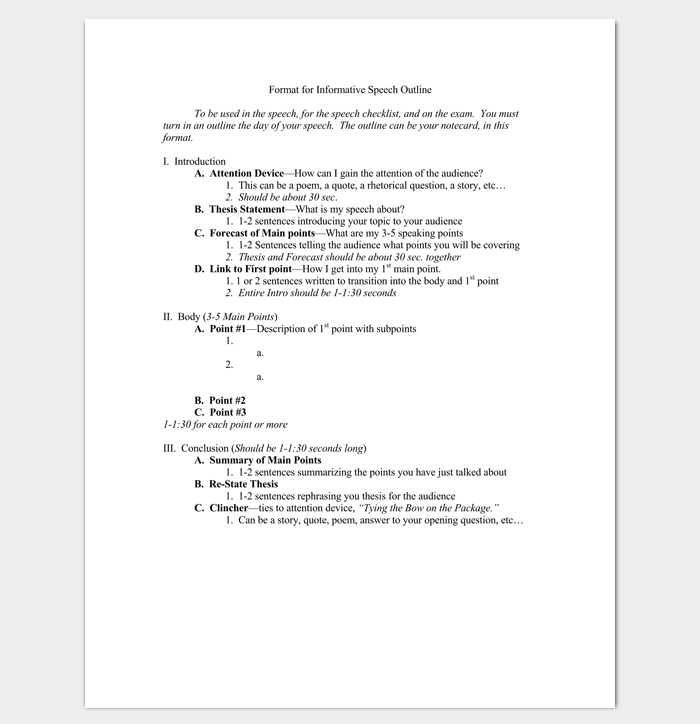
Sample Informative Speech Outline Template for PDF

Informative Speech Outline Example

Preparation Outline Template for Introduction Speech

Introduction Speech Outline Example
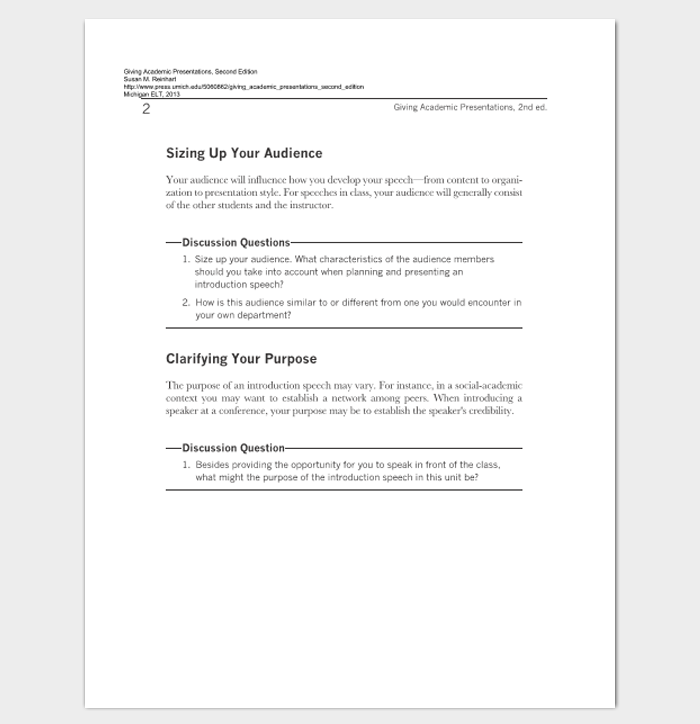
Sample Introduction Speech Outline

Self Introduction Speech Outline Template

Speech Preparation Outline Sample

Speech Preparation Outline Example
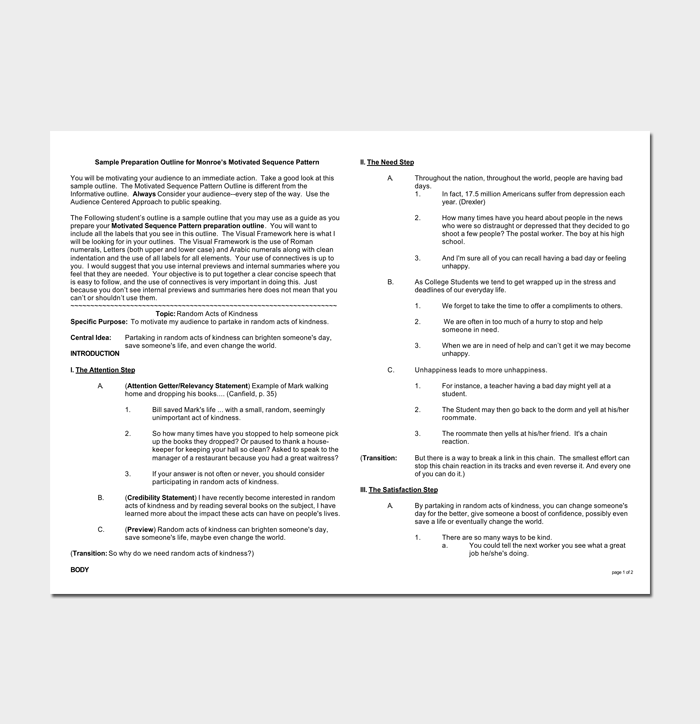
Expository Speech Outline Template

Demonstration Speech Outline Template
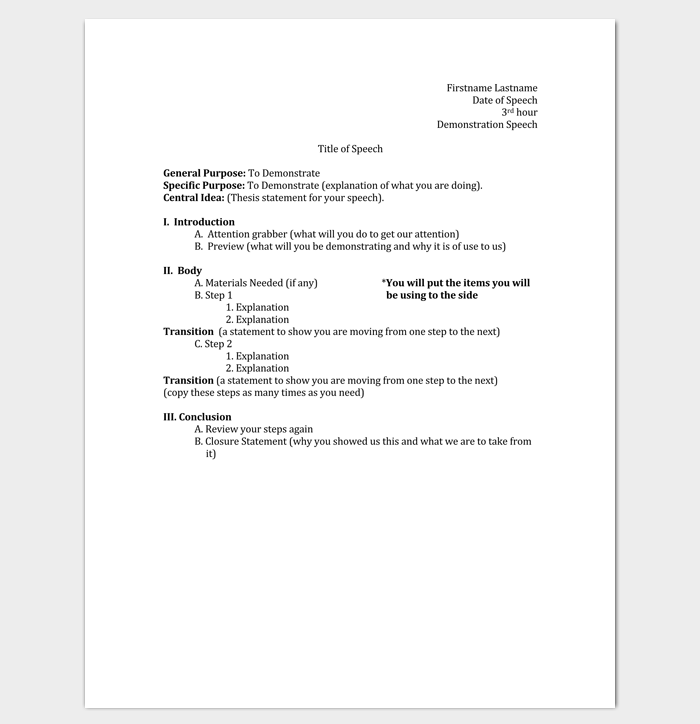
Demonstrative Speech Outline Example
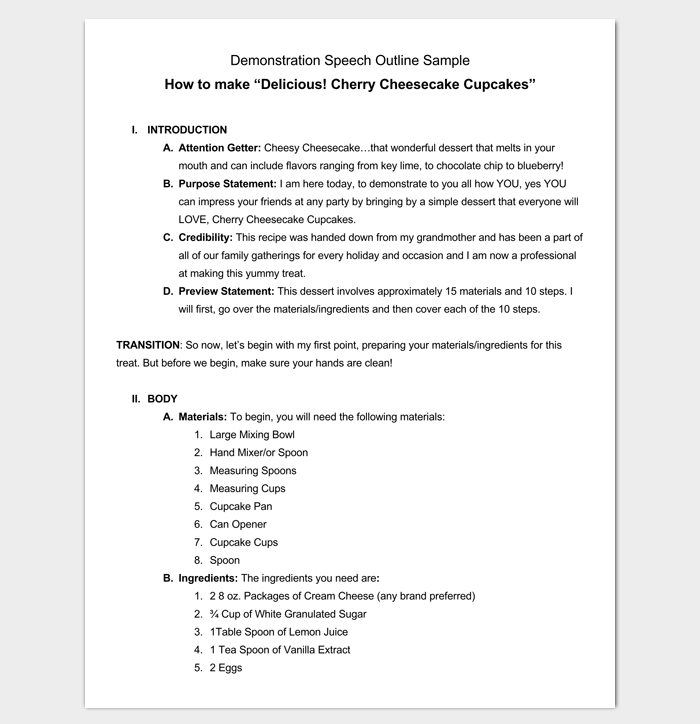
Demonstration Speech Outline Sample

Formal Speech Outline Template for Word

Commemorative Speech Outline Example
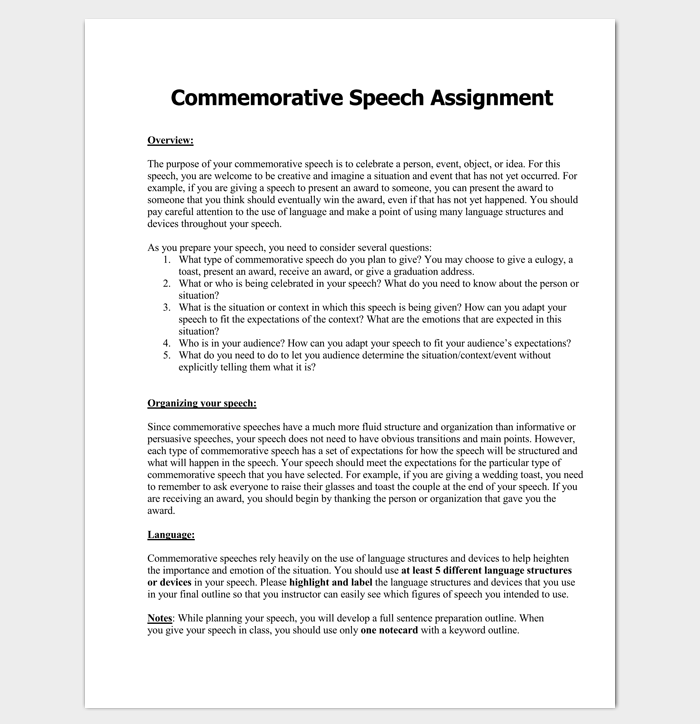
Sample Commemorative Speech

Elevator Speech Outline Example

Eulogy Speech Outline Example

Extemporaneous Speech Outline for PDF

Extemporaneous Speech Outline Sample

Persuasive Speech Outline Template for Word

Individual Persuasive Speech Outline Template

Persuasive Speech Outline Template (Plus Guide)

Persuasive Speech Outline for PDF

Sample Persuasive Speech Outline

Speech Outline Sample Format

Sample Acceptance Speech Outline

Gradation Speech Outline Example

Narrative Speech Outline

Ceremonial Speech Outline Sample

Speech Presentation Outline Example

Special Occasion Speech Outline Template for Word

Persuasion Speech Outline Template for PDF

Career Speech Outline Template for PDF

Hero Speech Outline for PDF
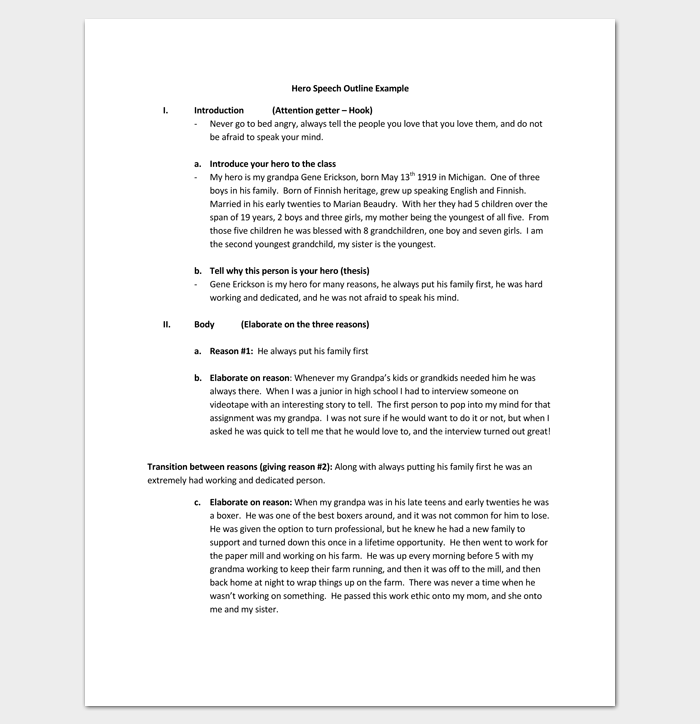
Speech Outline Format and Reference Guide

Some tips for preparing a speech outline:
- Most speeches or speech outlines will only have three to five main points- Making decisions about what is most important and relevant to your audience is a process greatly aided by the speech outline
- The average audience will give a speaker about 7 minutes before losing interest- This is neither conscious nor intentional. Stand-up comedy acts are just about the only exception to this rule. However, even with this allowance the speaker must still gain the audience’s attention. This need not be humiliating or extravagant. It can be as simple as a clean, quick joke; a relevant short poem; a simple quote; or an interesting fact.
- Practice your speech- Practice your speech in front of a mirror with a stopwatch to perfect your pace, delivery, and body language.
- Write it out- When assembling your speech outline write out your greeting, hook, thesis or main argument, credentials, preview, and transition statements in full sentences to prefect them and their delivery.
- Know your audience- Knowing your audience and fully understanding the purpose of your speech will better help you to make decisions on important points. .
- A properly completed speech outline organizes speech delivery so that the audience can make sense of what they’re hearing. A well developed and delivered speech lends credibility to the speaker and to the organization they are speaking for.
Leave a Comment
My Speech Class
Public Speaking Tips & Speech Topics
How to Craft a Masterful Outline of Speech

Jim Peterson has over 20 years experience on speech writing. He wrote over 300 free speech topic ideas and how-to guides for any kind of public speaking and speech writing assignments at My Speech Class.

I’m sure you have all seen at least one captivating Ted Talk online. One thing you probably noticed is how smoothly it went. I can assure you that every public speaker has done their homework and put together an outline of speech before presenting it in front of an audience. This wouldn’t be possible without some preparation beforehand.
An outline done right can do wonders for organizing your speech, and public speaking teachers often stress the importance of this organization tool. A rough outline can help you come up with more main points and sub-points for your arguments. It will help you brainstorm ideas. Some people use index cards with keywords or brief phrases from their speech outline to help them accurately deliver their speech.
The outline functions as a visual aid, too. Some people with photographic memory can use the outline as supporting material and ensure they do not forget crucial elements of their speech. Logically ordering your speech points can also smoothen your speechwriting process.
The speech outline is one of the most critical elements to have. Simply put, it has two main functions: it’s a point of reference and an organizational tool. Our guide will help you understand how an outline is used, the structure of an outline, and the different types, so you can create the most helpful outline for you.
In this article:
Preparation Outline
Speaking outline, the big picture, type of speech, call to action, speech outline structure, coordination, parallelism, transitions, speech outline types.
The preparation outline is your first draft. It includes the bare bones of your speech, and it’s often referred to as a working/rough/practice outline. You will write the main points of your speech, the supporting points, organized logically, and the other various components, such as attention getter and so on (we expand on the parts of a speech outline further in the article).
The preparation outline is used to help put your thoughts on paper and arrange your material. It is also the place where you should pay attention to your arguments. Are they convincing or lacking evidence? You might need to rearrange some parts to make your speech flows better. Don’t be afraid of removing parts of your preparation outline if they don’t make sense.
Can We Write Your Speech?
Get your audience blown away with help from a professional speechwriter. Free proofreading and copy-editing included.
The preparation outline is then transformed into a speaking outline. Even though your preparation outline should include full sentences, don’t forget your it is not an essay. Try not to get carried away with writing, and use it to get your textual arguments in order.
The speaking outline is your reference point. Unlike the preparation outline, this one is more concise includes keywords to serve as quick reminders during your speech. These short phrases should briefly encapsulate your main points, conclusion, introduction, and an attention grabber. Unlike the first outline, which uses long sentences and breakdowns of your textual arguments, the speaking outline could easily fit on cue cards and help prepare for your speech.
You shouldn’t solely rely on index cards, however, as you may come across as unprepared in the eyes of the audience. Most speakers use them to prepare for their speech and simply refer to them when they get stuck. Make sure to check the instructor’s requirements to see if you’re allowed index cards during your speech.
Things to Consider Before Outlining Your Speech
Before you get into arranging your outline, it’s essential to think about the big picture. Before you begin, consider three things: think about the speaker, the subject, and the audience. Here is more detail about each element:
Speaker – Why are you discussing the topic at hand? Why does this subject matter to you? Do you have any significant insights on the topic? Do you have any expertise or qualifications that can help convince the audience of the legitimacy of your words?
Subject – Are you covering a controversial topic? How do you think your audience will react to it? Are you going to make some interesting points? Try to predict the audience’s reaction s you can be more prepared for your speech.
Audience – What do you know about your audience? Are they all from a particular age group? Are they qualified in the same area you are? Are they familiar with your work? Has the audience paid to listen to your speech?
Try to take a step back and look at the big picture. You might find some exciting takeaways when doing that.
Think about the purpose of your speech. Are you there to convince the audience to do something? Or is your goal to inform the audience of some less-known facts? Generally speaking, there are two common categories of speech, and yours most likely falls under one of them:
Informative speech – the primary purpose of the informative speech is to educate the audience on a subject. The goal is to have the audience learn something and leave your speech with a better understanding of a specific subject. We have an in-depth article about informative speech outline with examples here .
Persuasive speech – a persuasive speech aims to convince the audience to do something or change their opinion on a topic. It is similar to a sales pitch and combines credibility, logic, and emotion to help convince the listener. We have in-depth article about persuasive speech outline here .
Before you start outlining your speech, make sure you have chosen your preferred type, as the outlines vary depending on your speech category.
The title is highly underestimated when making a speech outline. Logically we think that we don’t need one. Since we are more or less presenting the speech verbatim, we are not exactly going to stand in front of an audience quoting our speech title. But we might still need one. A title helps summarize your main goal. It holds the central idea behind your speech. You will have no trouble writing a title once you are sure what message you are trying to deliver.
What is the central idea of your speech? Is there e certain question you are aiming to answer? Determine the essential message behind your speech. Try to sum it up in a single sentence. Try to explain your message simply, without overcomplicating it.
Use your central message as a reference point throughout your speech. When you get stuck, write up your main points and supporting arguments, and always ask yourself, do they support the key message? If not, they might be redundant.
In order to make a captivating speech and maintain the audience’s attention, you need to think about the relevance of your message. You should always put the audience first, so now that you have your key message prepared, list the reasons why the audience should care about your message. Is it relevant to them somehow?
Think of at least one reason why the speech should matter to your audience. For example, if you’re writing a persuasive speech about texting and driving, the audience would find it relevant because it concerns their safety. If you can’t think of a relevant reason why the listeners should care about your speech, reconsider your message.
You have probably heard about hooks before when you used this technique to begin your essays. The hook is the attention-getter, and it is paramount to your speech. It’s the first sentence your audience will hear and usually determines whether or not your audience would listen to the rest of your speech. There are many clever ways to start your talk and ensure you’re being heard:
- Ask the audience a rhetorical question.
- Start with a joke.
- Tell a short personal story.
- Recite a quote.
- Prompt the audience members to do something.
Speaking of encouraging the audience to do something, this brings us to our next point.
When presenting a persuasive speech, you’ll most likely need a call to action. The most convincing speeches prompt the audience to make some kind of action. You can ask them to raise a hand if they have done something (drink more than 5 cups of coffee a day). Alternatively, you can ask them to scan a QR code to reveal some useful information on the topic at hand. These small steps will move the audience in the right direction.
Now that you have prepared thoroughly, you can formulate your speech outline. Get familiar with the main points of your speech. You can find examples and references below, explaining each topic. Remember that all the various elements of your speech will make an organizational pattern supporting your central thesis (key message). An organized speech has main points, typically between 2 and 5, and any supporting material is put in your outline as a sub-point.
A Roman numeral numbers every main point, while subpoints are listed with capital letters. The hierarchal order that follows is Arabic numerals and, finally, lowercase letters. For further subordination, speak to your tutor or the person in charge of your public speaking project.
Here is the basic speech outline, including an introduction, body, and conclusion. For planning purposes, each section is explained to understand the textual arrangements best. Examples are given later in the text.
Every basic speech outline includes an introduction. This is your speech opening, and it needs to be robust and captivating. It is critical to prepare a compelling introduction. An introduction has 3-5 parts, depending on the length of your speech.
- Attention getter – Capture the audience’s attention.
- Thesis statement – Your key message is introduced here with a couple of short sentences.
- Motivation – Explain how this speech will be relevant to the audience
- Qualifications – Explain to the audience why you are qualified to discuss this topic
- Transition – Smoothly transition the audience to the next part of your speech
The body is an integral part of any basic speech. Here you can develop your thesis in detail. The body holds the bulk of the information you will be presenting in front of an audience. It is important to do plenty of research on your speech topic. Gather content you might need during your talk. are you going to need any visual aids? Perhaps make some charts of your statistics. Or, if you’re going for a humorous approach, some memes on the topic can get the audience laughing and hungry to hear more on the topic. Aim for a sheet full of ideas. It’s worth noting that too much information doesn’t mean better speech. Once you have gathered all your engaging material, subtract some supporting material that you feel isn’t genuinely helping your presentation. You shouldn’t try to talk about everything. Instead, choose what is most important and focus on making it relevant and believable by adding sub-points:
- First subpoint (Give some support to the reason above)
- Sufficiently supported statements (Provide more factual arguments to support the above statements)
- Sufficiently supported statements
- Second subpoint (Structured like the one above, with its supporting point listed below)
- Sufficiently supported statements (…)
- More points, following the above guidelines
- Transitional statement
- First subpoint (Supporting the main point)
- Continue organizing your outline this way.
- First subpoint (supporting the main point)
- Continue your outline as shown above.
The grand finale of your speech is where you must tie together all previous elements in a clear and solid point.
- Summary – Here, all your main ideas and points will connect together and formulate a convincing conclusion. You can provide short examples of why the listeners should agree with your proposed thesis:
- Call to action – give the audience members a suggestion, something they can do to support what they have learned. Or instead, think of a unique or memorable ending to your speech.
- Closure – Bring the speech to an end by thanking the audience for their time.
- Bibliography – in some cases, you might get asked for your bibliography of references. If you’re using many statements, quotes, or statistics from various sources, remember to collect them throughout your research.
Let’s help you visualize these instructions and see how these elements correspond by looking at an example.
Topic: Hypoalergenic Cats
Specific Purpose: To debunk the myth of hypoallergenic cats.
Thesis: Despite there being breeds of cats known as “hypoallergenic”, no cat breed is guaranteed to relieve you of your allergy symptoms.
Preview: I will talk about the misconceptions behind cat allergies and explain how they work.
Here is an example of the structure of a Body:
- People are allergic to a protein called FEL D1.
- The protein is contained in the cat’s saliva.
- The saliva is being transferred to the cat’s fur during their cleaning process.
- This fur is spread around your house in the form of dander.
- People are not allergic to a cat’s fur, just the protein.
- This means you could be allergic to some cats, not all of them.
- Get a check-up and find out if there are any medications you can take to ease your allergy symptoms.
- Vacuum regularly around your house to reduce cat hair and dander spreading.
- Swap your drapes with blinds and carpets with hardwood floors. That way, less fur will stick to your furniture.
- Buy HEPA air filters for every room.
- Clean out their litterbox more often.
- No cat is hypoallergenic.
- All cats make the protein FEL D1.
- Some breeds are known to produce less FEL D1, but there is no guarantee you won’t be allergic to them.
- Even the “naked” cat breeds such as Sphynx, Donskoy, Bambino, etc., produce FEL D1.
- Buying “hypoallergenic cats” only creates a bigger rehoming problem.
- Many cat breeders like to use the myth of hypoallergenic cats to sell expensive cat breeds.
- Once people realize the cat isn’t hypoallergenic, they can no longer keep it.
- The cat is either thrown out, put in a shelter, or resold, creating tons of stress for the animal or potentially resulting in its death.
Now that you know the structure of a speech, you are almost ready to start writing it. By all means, if this has inspired you, grab a sheet of paper and write down the ideas that come to mind. But before you start putting your outline on paper, double-check you are familiar with the rules of outlining a speech.
Rules in Outlining
Speech outlines follow a specific set of rules. Going by these rules will only help you polish the particular details that make your speech stand out. To double-check that your speech makes sense, go through your outline and give it another read to check for coherence. Here are some characteristics you should pay attention to:
Think of your outline as a staircase – your final draft should have subordinate points diagonally placed beneath your main points. They should all interlink and reference one another.
Looking at the example from the section above, points A. and B. explain what determines a cat allergy and what doesn’t. Points 1-3 give information on why the protein affects people and debunks the myth that people are allergic to cat hair . Points 1-3 are called subordination of point, just like A., B., and C. are to main point III. Your overall organizational pattern should not only include Roman numerals, points, and thesis statements. It should be cohesive and coordinated.
Another important part of speech writing is parallelism. It is the concept of beginning sentences similarly whenever possible, using similar grammar. Pay attention to our example once again. Note section II and the subordinate points of main point B. – all points start with a verb: “Get,” “Vacuum”, “Swap,” “Clean.” This type of structure adds clarity to your speaking and shows you have really paid attention to your full-sentence outline. Don’t worry about sounding boring – parallelism helps you sound acute!
Another essential part of your speech outline is division. The concept is simple – when you’re trying to make one point, you should also try to expand it. If your point is convincing enough, it will have plenty of meaningful information that you can lengthen in sections A. and B. Similarly. You can use a supporting point for sub-points A. and B. to help expand them, and so on. Remember you’re doing this only to support your main thesis statement. If your sub-points aren’t doing that, you might be waffling on and confusing your audience.
A clever way to connect your main points is by using transitional statements. In most cases, speakers use these sentences to glue together two distinctive (yet connected) ideas. That way, the audience is prepared that something else is being discussed. You have used transitional sentences in essay writing. Maybe these words will ring a bell: “next”, “also”, “moreover”, “firstly”. These words and phrases will greatly improve your writing skills and, eventually, your entire speech.
There is another way you can integrate a transition into your speech – by using non-verbal transitions. Adding brief pauses or moving around the stage grabs the audience’s attention and helps them understand some other concept is being introduced. Most extemporaneous speakers take it to another level by stepping out of the podium or raising or lowering their voice rate. These can all be signals to your audience that a transition is taking place.
A third way to include transitions into your speech outline is to make internal summaries. To write an internal summary, summarize what has already been said in a brief sentence or two. For example:
So far, we have explored why n cat can be hypoallergenic. But does that mean you can be less allergic to some cats?
We have hinted at the next point in our speech with this question. We could also use a summary to build on an issue we are currently expanding:
Now that you understand how cat allergies work, let’s see if there is a way to share your life with a cat despite being allergic.
How to Write an Outline for a Persuasive Speech, with Examples
30+ Controversial Opinions That Will Get You Thinking
1 thought on “How to Craft a Masterful Outline of Speech”
just fyi, most of you guys links are no longer vailed
Leave a Comment
I accept the Privacy Policy
Reach out to us for sponsorship opportunities
Vivamus integer non suscipit taciti mus etiam at primis tempor sagittis euismod libero facilisi.
© 2024 My Speech Class

IMAGES